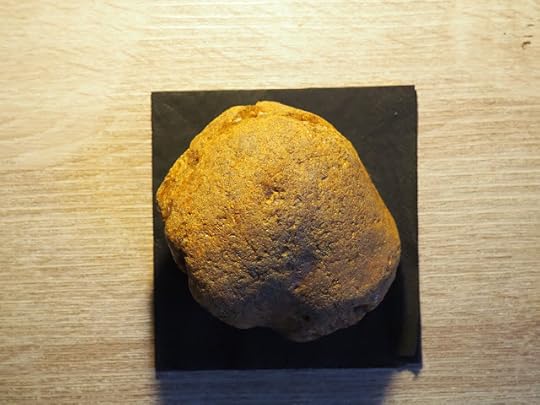Geoff Nicholson's Blog, page 6
December 29, 2023
THE CONTROLLED WALK
I always enjoy the post-Christmas, pre-New Year walk; it’s never very serious or arduous but among other things you do get to look at other walkers. Some no doubt are fully paid up pedestrians, but some definitely aren’t, and I imagine a certain percentage are having their only walk of the year. Still, a little’s better than nothing. (The picture below is from a different Christmas walk).
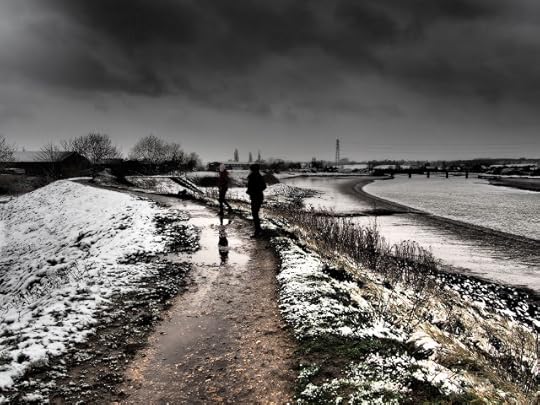
We didn’t go very far, up to the estuary, past the WW2 pill box, and home via the supermarket, which we surprised to find open. But along the way we did see these things, were new to me, a couple of what at first looked like pig sties, though this isn’t pig keeping territory, and they were in with grazing sheep, so I suppose they were sheep shelters, and I thought they had a lot going for them as examples of minimalist architecture.
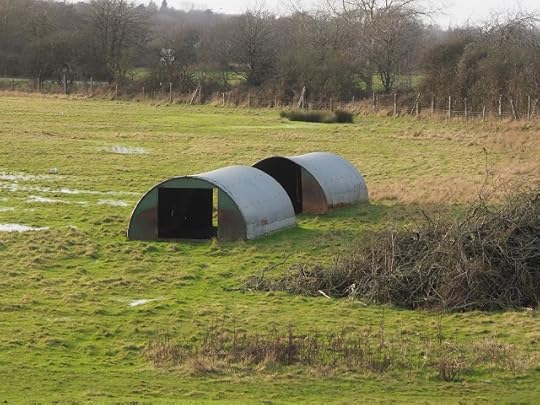
I’m not pretending this was one of the great walks of the year, however as you know by now, I’m a sucker for the detritus, the flotsam and jetsam that you find while walking. It was a good day for that. First, this nicely distressed metal plate from a Ford – my old Escort had one of those, and it did fall off but only on the driveway so I could retrieve it, and I still have it in the archive.
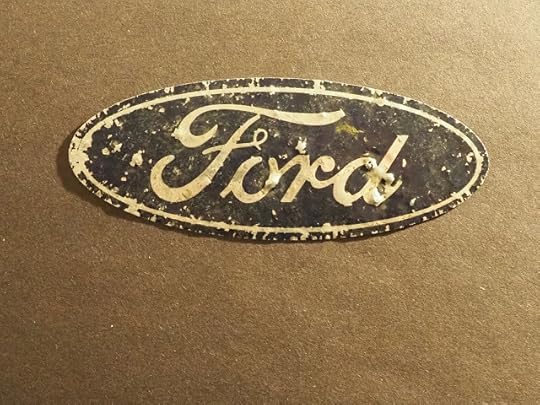
The second, far more inscrutably, is the label, complete with staple marks from (I assume) a package of legally obtained drugs. I mean I don’t suppose a real drug pusher would bother with that kind of labeling, but I could be wrong.

December 22, 2023
PROMENADING WITH PEPYS
Finding myself near the Tower of London, I decided to walk to (and in) Seething Lane Garden, a place I knew a little about but had never been to.
Chiefly what I knew was that Samuel Pepys had once had a house there, in the Navy Office, his place of work. Both house and office are long gone, and Seething Lane Garden, is a sliver of land tucked in beside the Four Seasons Hotel, what used to be the headquarters of Port of London of Authority.
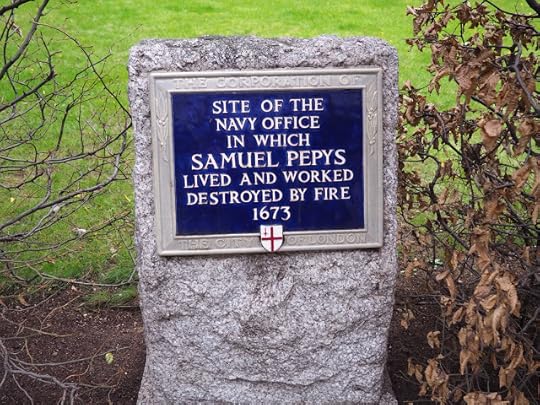
The garden is far too small for a ‘serious’ walk: by some accounts it’s a ‘pocket park,’ which only adds to my confusion about the difference between parks and gardens, but a walk doesn’t always have to be serious.
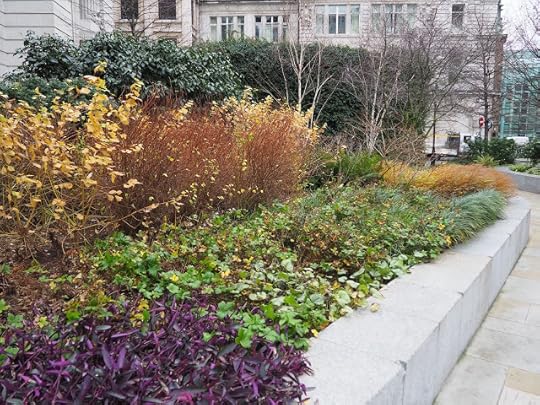
On the day of my visit the garden was wintry and windswept, which was only to be expected in December. Presiding over it is a very fine bust of Pepys, created by Karin Jonzen and put up by the Samuel Pepys Club in 1983.

On the ground are some even finer paving slabs showing a map,
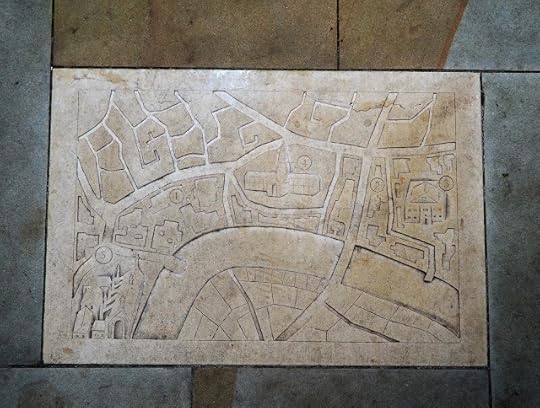
a plague doctor,

among others, but best of all is a parmesan cheese, like the one Pepys buried in his garden to save it from the Great Fire of London.

I suppose the pavers are there be walked on but I and the few other people I saw in the garden seemed to take pains to avoid them as though they were too precious for tramping feet. The pavers were made by past and present students of City & Guilds London Art School under the direction of Alan Lamb of Swan Farm Studios Ltd.
I was pleased to have walked in the Seething Lane Garden but it didn’t take long and isn’t one of the great London walks. Rather more fun can be had in and around St Olave’s church just across the road, though the address is Hart Street rather than Seething Lane, and best known (to me, anyway), for its skull-festooned gateway.
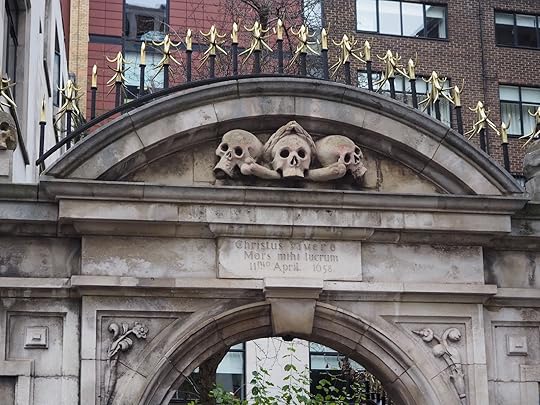
Dickens liked it too apparently. The churchyard and the garden were again wintry but there was a labyrinth – some walkers do enjoy a labyrinth:

Inside the church there are memorial busts of both Sam Pepys and his wife Elizabeth; their bodies are buried in the vault, away from prying eyes.But you know, the thing that really delighted me, the small thing that made the day for me, was a piece of stained glass in the church – showing teasels. Nature it gets everywhere
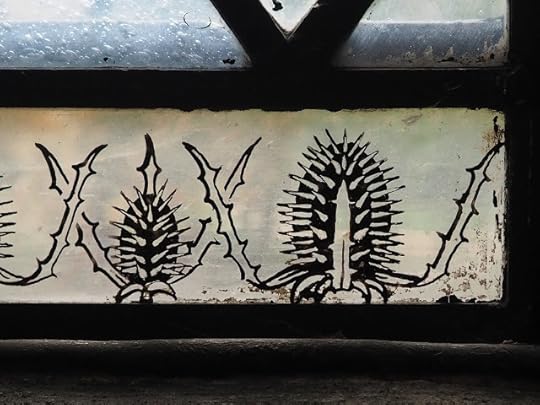
In fact, as I soon found out, the teasel is a symbol of the Worshipful Company of Clothworkers, of which Samuel Pepys was Master, but I’d have been perfectly happy for it to remain an enigma.
Pepys himself was, of course, a great walker. The word walk and its derivatives appears 1068 times in the Diary. There’s a really good book by Jacky Colliss Harvey titled Walking Pepys’s London. I recommend it, though your feet will get tired.
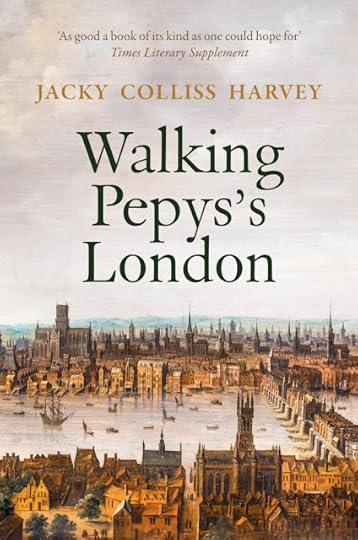
December 20, 2023
IT'S NOT JUST THE GRAMMATICAL ERRORS ...
December 15, 2023
AN OCCASIONALLY WEARY AND SOMEWHAT LONESOME TRAVELLER
Life being as it is, it turns out I’m in the current issue of National Geographic Traveller, writing a very short piece about walking in the American desert. The opening is below.
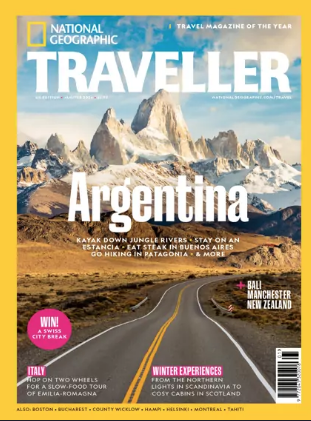
More than that they’ve got an illustrator (Jaqui Oakley) to do my portrait – from photographs not from life - a perfectly decent-looking man who only very very vaguely resembles me.

The first two paras of the article:
Geoff Nicholson
NOTES FROM AN AUTHOR
The memories of my first encounter with the California desert are so clear and intense that sometimes I wonder if I invented them, but I don’t believe so. I was hitchhiking across the States —it was the 1970s —and I was a young Englishman ‘on the road’, having read too much Jack Kerouac. My lift dropped me at a gas station near Barstow, a city in the Mojave Desert, in the south of the state. The car was air-conditioned and as I got out, I was hit by a wall of heat as strange and thrilling as anything I’d ever experienced.
I was wearing a cotton T-shirt, and I went into the petrol station’s bathroom to drench it in water, then went out looking for a place to hitch. By the time I found one, the T-shirt was completely dry. It was a learning experience, proving that the desert has to be treated with huge respect. It isn’t a monster, it won’t bite you, but it does demand that you’re on your mettle. That was the start of a long relationship with the American desert, chiefly the Mojave, especially Joshua Tree National Park, Yucca Valley and Death Valley. I’d always lived in cities and done lots of urban walking, but the moment I set foot in the desert I knew it was a very special place for me. Nothing in the English landscape moved me the way it did. I began to make regular desert trips and for a decade and a half I lived in Los Angeles. I had many reasons for moving there, but the fact that I could be in that landscape in a couple of hours was a large part of the attraction.
December 11, 2023
RUSKIN ROCKS, AND SO DO I

Last year, at LAX airport coming back from a trip to the States, my luggage and I got pulled aside by security. I’m one of nature’s worriers but I didn’t think I’d done anything wrong, and I knew that I had, a little reluctantly, left my legal recreational marijuana behind.
It turned out that the security woman had looked at the X-ray of my bag and seen something worrying in the side pocket. I unzipped the pocket and found that the thing worrying her was a rock that I’d picked up while walking in the Mojave desert.
Fortunately I did not end up being interrogated in a small room by uniformed men with small mustaches. And when I showed the rock to the security woman who’d pulled me over, she seemed to find the situation, and me, rather quaint and charming, and she let me go on my way with my rock. But I couldn’t help worrying that maybe a stricter woman or man might have taken it more seriously and accused me of trying to steal part of America, like it was the Elgin Marbles or something.
I think this is the rock in question but I’m not 100 per cent sure. I really need a cataloguing system.
This year the inamorata and I were walking in the Saguaro National Park, in Arizona, on the Broadway Trailhead, a very dramatic-looking but incredibly safe- feeling bit of walking territory with people just going for an afternoon stroll or exercising their dogs,
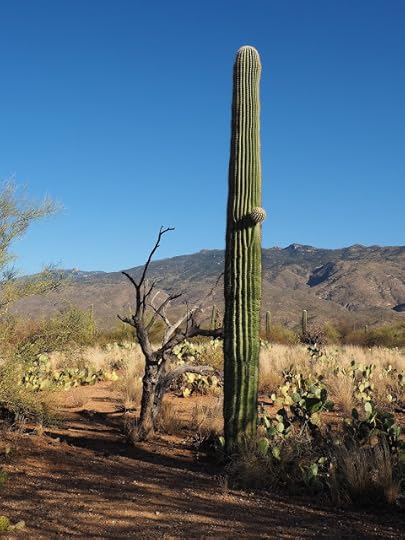
And we saw a man heading towards us who was jogging rather than walking and he had something in his hand and he slowed when he got near and he said, far more to the inamorata than to me, ‘It’s turquoise and copper. I collect pieces to give to people,’ and he handed her a very small rock he was carrying, perhaps just a pebble, that looked, and stills looks, like this
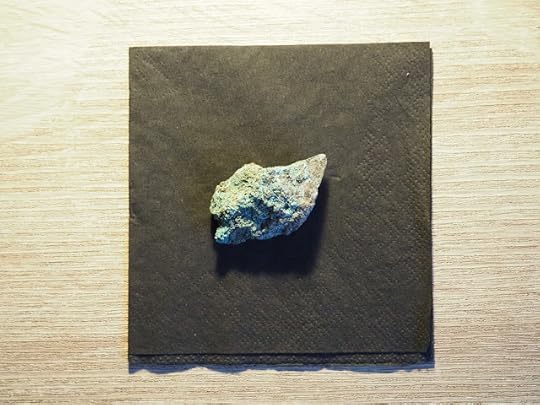
To my untutored eyes it didn’t look much like either turquoise or copper but it was a nice little gift. We had no problems at all at airport security.
And the two weeks later in Sheffield, England we saw some of the Ruskin Collection, and it turns out, and I did sort of know this anyway, that John Ruskin was quite a collector of rocks, displayed in the museum like this:

They seem to have a very adequate cataloguing system
December 5, 2023
WALKING WITH TOM AND THE LORD
Tom Waits is always with us, and he’s especially with me whenever I walk in a garden and I remember his song ‘Way Down in The Hole’ with the lines that run,
‘When you walk through the garden
You gotta watch your back’
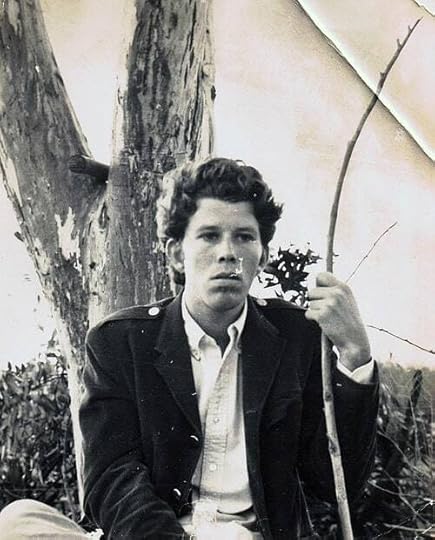 As close as I can get to a picture of Tom waits in a garden.
As close as I can get to a picture of Tom waits in a garden.
I assume this refers to the Garden of Gethsemane but I think perhaps it applies to walking in many, perhaps most, gardens.
Of course I knew that the Garden of Gethsemane was where Jesus prayed the night he was betrayed by Judas and where he experienced his ‘agony.’ But lately I discovered there are at least four potential locations for the Garden of Gethsemane. All of them are near the Mount of Olives, but theCatholics reckon it’s the garden at the Church of All Nations built over the ‘Rock of the Agony,’ or maybe it’s by the Tomb of the Virgin Mary to the north. The Orthodox Greeks reckon it’s to the east. The Orthodox Russians place it in the orchard adjacent to the Church of Mary Magdalene. I think I’ve got that right but I stand to be corrected by true believers.
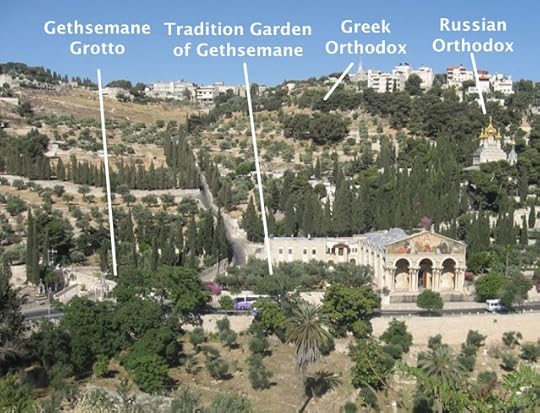
Now, I don’t imagine I shall ever walk in the Garden of Gethsemane (though I gather there are plenty of bus tours), and for that matter I don’t think I’ll be following Waits’ advice that ‘If you walk with Jesus, he’s gonna save your soul.’ However, I have been walking among sculptural representations of the Lord, in the Desert Christ Park, on Sunnyslope Drive in Yucca Valley, and I have least peered into an artistic representation of the Garden of Gethsemane. I shall explain.
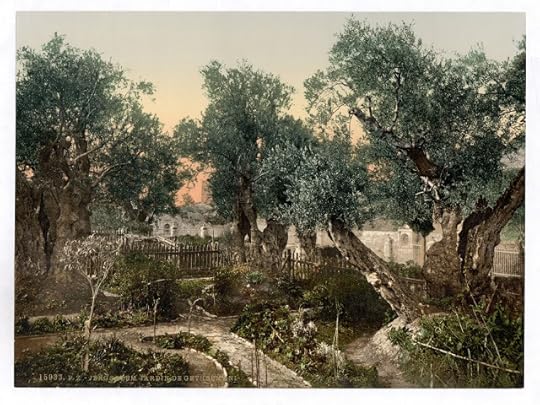
Now, one of the things I sometimes think about while walking in gardens, is what’s the difference between a park and a garden: and OK I agree its not one of humanity’s most pressing questions. However the Desert Christ Park had me thinking again.
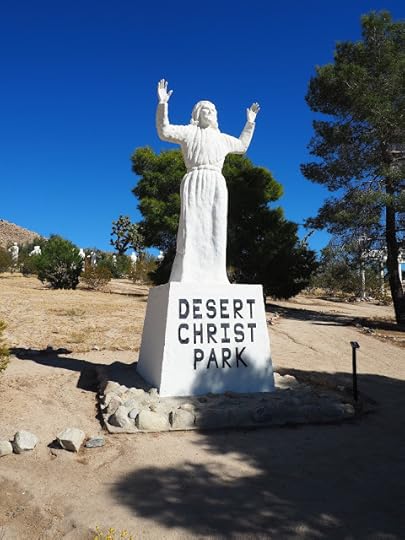
The name would seem to define it as a park, but their mission statement reads, ‘To provide a desert sculpture garden of hope, prayer and beauty; by sharing the Peace of Christ through art.’ So does that mean the place is simultaneously a park and a garden. Maybe.
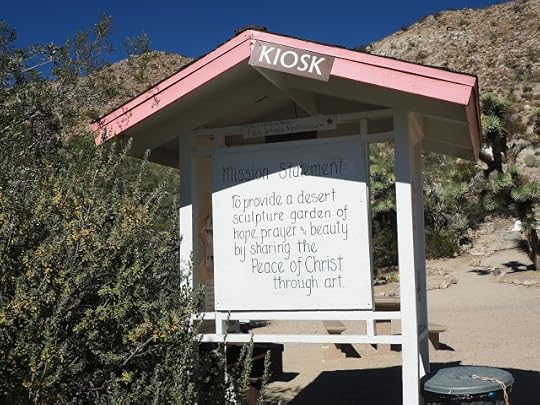
The Desert Christ Park was established 1951 when a single concrete statue of Jesus was placed there. The statue was by Antone Martin, sometimes described as a sculptor-poet, who looked like this, which is pretty much the way you'd want him to look:
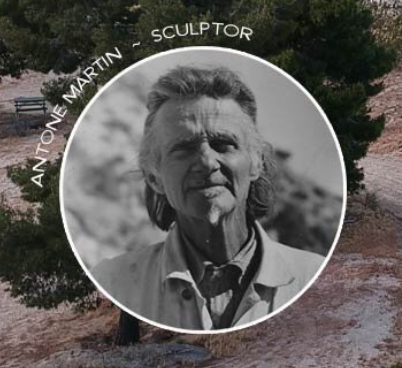
He’d wanted to have the statue installed at the Grand Canyon but the authorities wouldn’t go for it. However, the Reverend Eddie Garver who was pastor at the Yucca Valley Community Church, and had acquired five acres from the government to form what he hoped would be a Christian theme park (or I suppose garden), was happy to have the statue on his patch.

Over the next decade Anton Martin made many more statues, most of them created in situ. Jesus is consistently portrayed as a good looking feller, long hair swept back, a beard, mostly with very serious though a smile seems to occasionally to play about his lips. He does, of course, look very white.
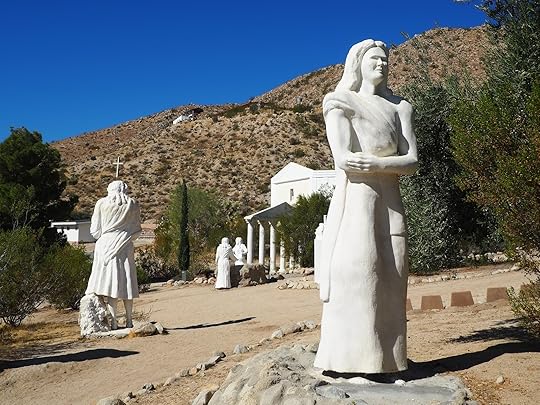
Many of the statues are part of tableaux; Blessing the Children, The Last Supper, Sermon on the Mount, and of course the Garden of Gethsemane - Jesus on his knees praying, while the disciples Peter, James and John are asleep. This kind of thing:
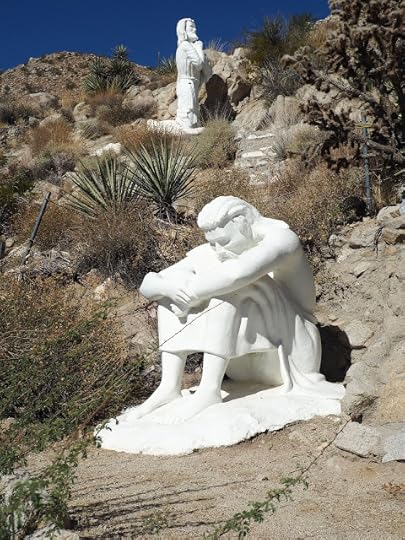
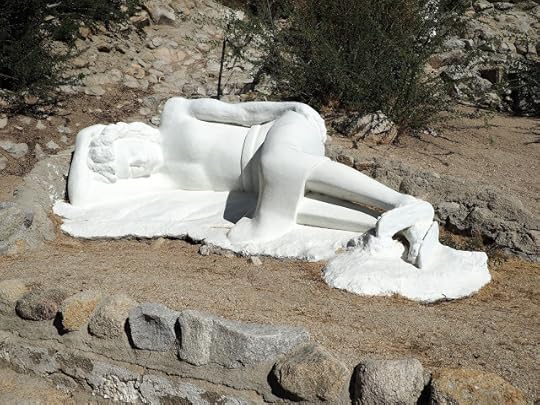
Though in fact you can’t get very close because of this stern bit of signage.
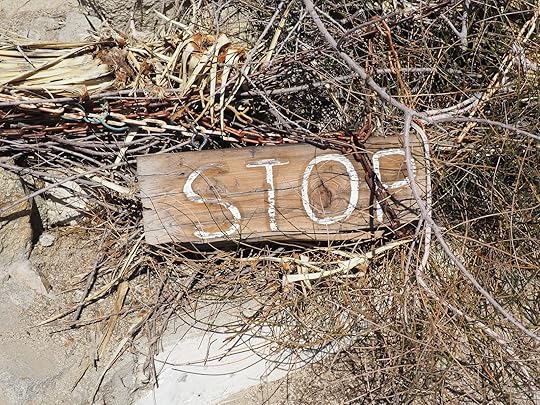
I’ve been going To the Desert Christ Park once in a while for over two decades now, and there was definitely a period when the place went into decline. The concrete is formed around armatures of rebar. Some of the ‘flesh’ on the fingers had fallen off in places off over the leaving Jesus with metal spikes for hands. To be fair this did have a certain grim appeal.
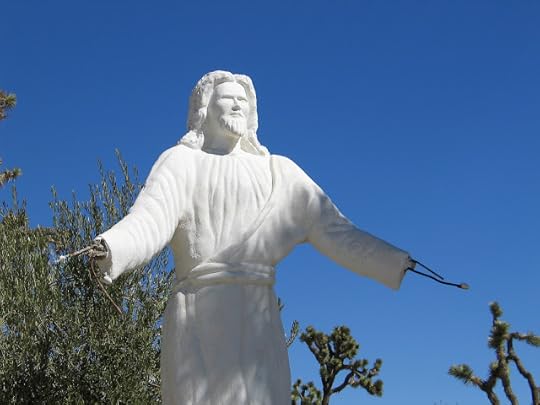

But when I was there a couple of months ago, a lot of repair work had been done, though there was still the occasional chipped or missing nose, which seems forgiveable.

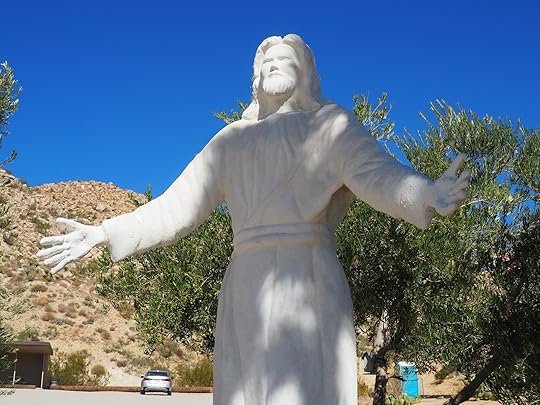
Contemporary and historic photographs show the Garden of Gethsemane to be dense with gnarled olive trees – some of them reckoned to be 900 years old. And the Desert Christ Park has some glorious olives trees.

Some of them are also bedecked with wonderful, architectural birdhouses, an idea I may steal for my own unreligious garden.
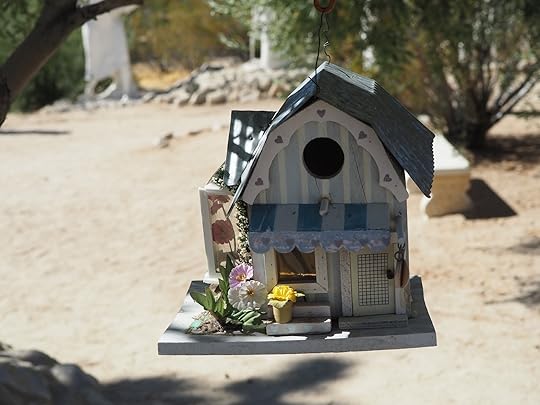
Now in some ways it’s hard to take the Desert Christ Park entirely seriously. There is something faintly absurd about the enterprise. And Antone Martin is no Michelangelo. But then who is?

On the other hand, having walked around and among Anton Martin’s statues, I find it impossible to find the concept entirely ludicrous. The place is rich with belief, sincerity, spiritual commitment. You emerge, or certainly you can emerge feeling good, feeling charmed and uplifted. I didn’t even feel that I had to watch my back.
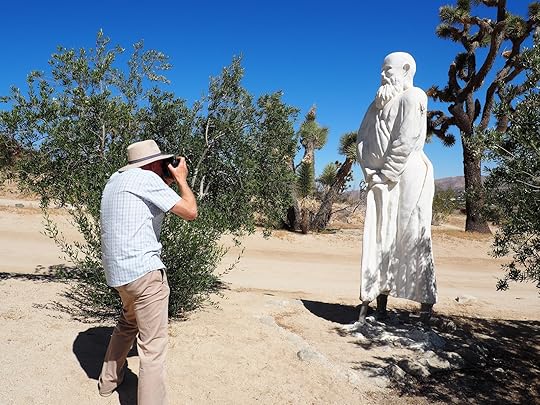
November 28, 2023
DESERT BEACHES

I’m not surely exactly when I ‘discovered’ the Salton Sea, but I know it was some time in the 1990s and I’d driven out there from Palm Springs, not knowing what I’d find. Of course the Salton Sea didn’t (and doesn’t) need any actual discovering, though it does seem to be one of those places that’s constantly being reinvented and reimagined.

On that day twenty some years ago, I arrived in North Beach at the top end of the sea. I was part desert rat, part dumb tourist and I found myself in a Ballardian landscape; empty motel, abandoned swimming pool, pelicans on the water.
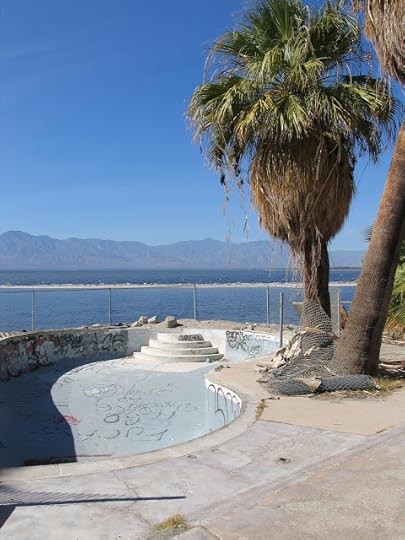
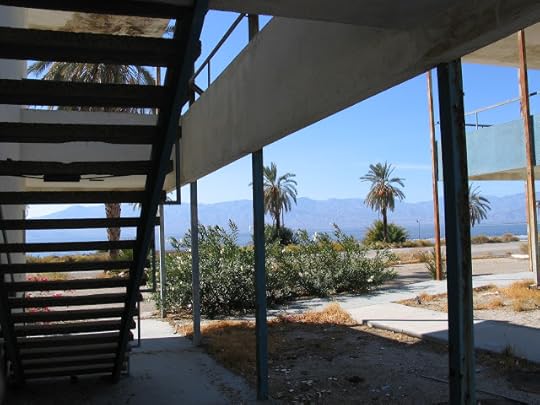
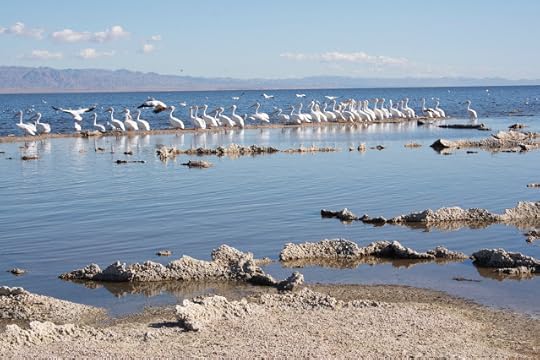
And I especially enjoyed the shuttered North Beach Yacht Club, designed by Albert Frey, which I understand has since been restored at considerable. Back then it looked like something from the future of the past.

I thought I’d set foot in one of the most wonderful places on earth.
The Salton Sea is a Johnny-come-lately of the California landscape. It came into existence in the very early part of the twentieth century when canals were built, diverting water from the Colorado River into the dry lakebed of the Salton Sink, and for a while the land became fertile and agriculture thrived.
But then the Colorado River burst its irrigation channels and vast amount of its water went into the Salton Basin; a disaster for farms and the farmers who lived there. It took a while to sort that out.
Much, much later, in the 1950s, there was Salton City, intended to be a swanky desert resort, but with water. That worked for a while but then flooding, pollution, and high salinity made the Salton Sea a much less appealing holiday destination.
Of course none of this deterred a certain kind of desert lover and desert dweller. Not so far away from this ‘planned community’ was and is a community of a different kind: Bombay Beach which is a sort of ghost town and a sort of hippy exclave: though now according to sources it’s an ‘art hub.’
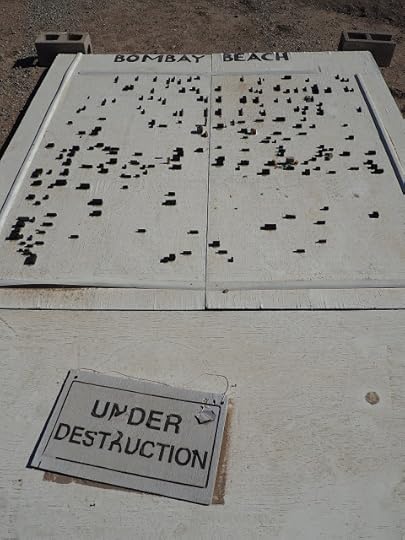

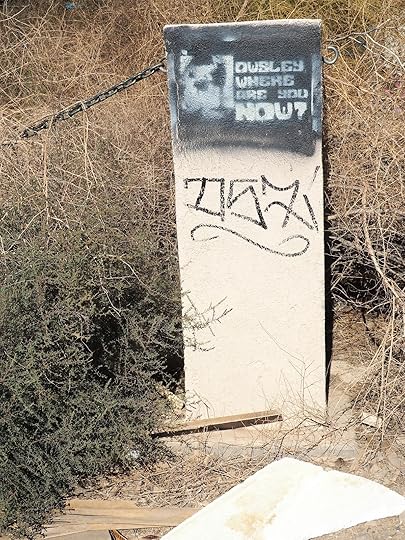
So that’s where we went. We walked on the beach, we looked at the art, we talked to a few other walkers, we observed some dangerous looking black smoke on the horizon. Without being too intrusive we looked at the various curious ways people live there. It was great.


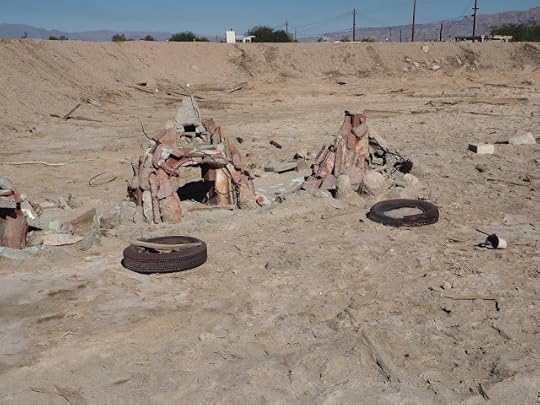

And later, not wanting to do the same old same old, we went to Salt Creek where I hadn’t been before. It looks like an unspoiled stretch of desert shore, and naturally you want to walk across the sand and shingle and fragmented fish bones to the water.
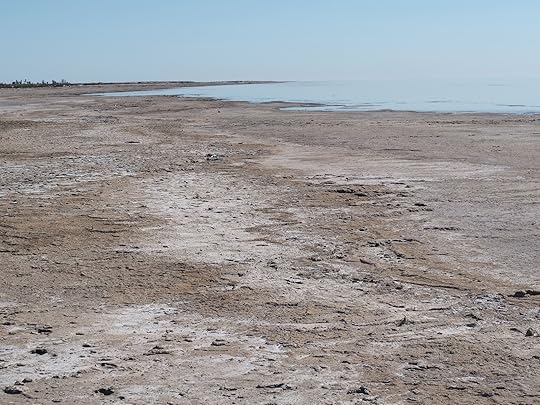
I tried but I didn’t quite make it. The land seemed perfectly solid underfoot but before long my feet went through the top crust into the mud beneath. That was fair enough and much as expected, and I could deal with that. I’d done it often enough before. But then a little further on my feet through the mud into some hideous black tar. Once your foot went in you needed colossal strength to pull it out against. It was impossible to walk there. We turned back, returned to the sand and gravel, feeling like failures.
 Pic by Caroline Gannon, as are all the ones below.
Pic by Caroline Gannon, as are all the ones below.And then I looked at my shoes. They were not a pretty sight. In fact I didn’t think I could ever wear them again, certainly not to go out to the martini bar I had in mind for the evening.
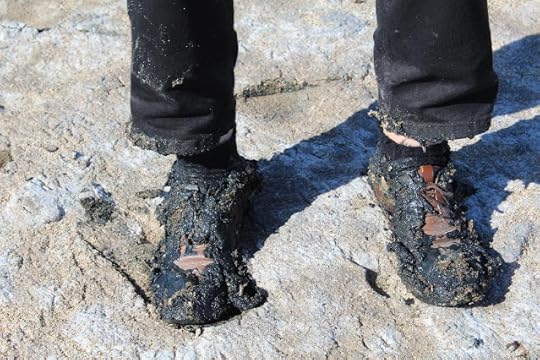
So I schlepped to the thrift store in Palm Springs and bought some decent looking shoes that cost all of 3 dollars and looked like this:
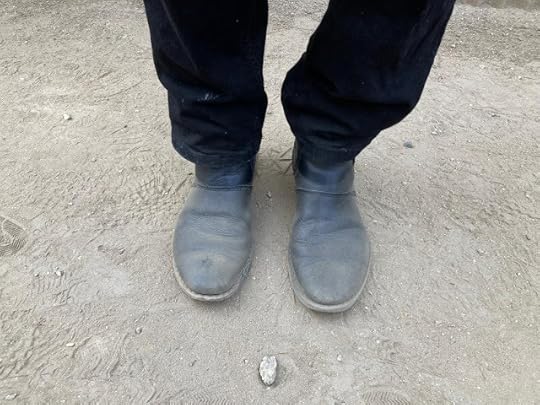
And they lasted all of three days before one of the heels came off.
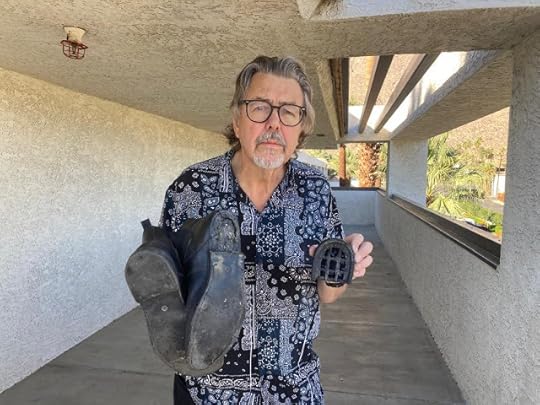
The desert, she’s a tough mistress, and very hard on the shoes.
October 27, 2023
COMMANDO WALKING
I discovered Anaïs Nin the way many people do, via Henry Miller. I haven’t read either of them for a very long time and haven’t felt any need to, but as I recall the attraction of Nin was that really liked and really wanted sex, at a time when few women of my acquaintance felt that way. Yes, I was young and green in judgment.

The one thing I missed at the time as I read Nin’s diary and ‘erotica’ was that she was a walker, but I know this now thanks to Kerri Andrews’ Wanderers: A History of Women Walking.

Andrews writes, ‘For Nin there was an important link between sexual experience, sexual confidence and the development of her literary voice, all of which were bound up with the ways in which she walked through the city.’
That all sounds fair enough, but there’s more. Andrews also writes ‘Walking the streets of Paris in this hyper-aroused state seems to create within Nin an almost-orgasmic connection with everything she encounters ,,,’
Please note that’s ALMOST orgasmic, or in other words, not actually orgasmic at all) and the paragraph continues, and here’s the beauty part ‘These sensations are enhanced by way of the state of partial dress, with little by way of underwear, that Nin describes as “walking poor”’
I missed that at the time and as far as I know I’ve never previously heard that expression.
I haven’t been able to find an image of Nin walking poor, or walking any way at all, but here she is as a Spanish dancer.

And here she is on one of those quotation sites.

October 24, 2023
WALKING WITH WELLIES
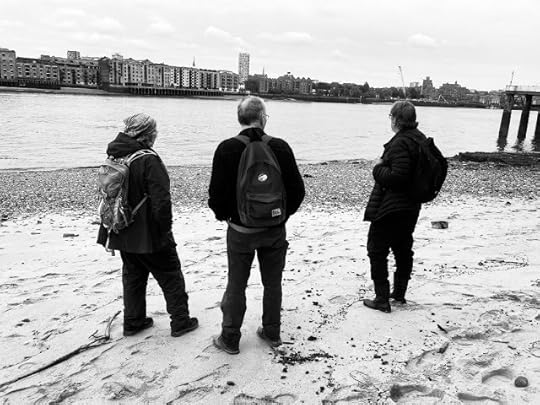
So we walked, the four of us, Jen, Jonathan, Caroline and me (Caroline took the picture above which is why she's not in it but she's in the one below), on the foreshore of the Thames, between Bermondsey and Rotherhide. The tide was low but gradually coming in. It was a short and only occasionally tricky route but it had a lot going for it. I’d never previously set foot on the foreshore, had only vaguely thought about it, but Jen, the instigator of the expedition, was quite the aficionado. It was a great walk. And I was glad I had my wellies.
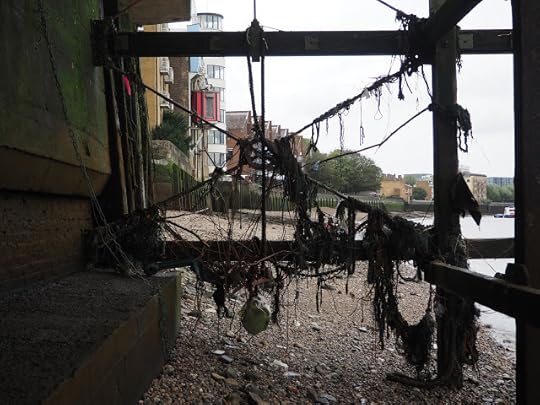
The foreshore was full of curiosities, both natural and man made: rocks, oyster shells, eroded bricks, tires, driftwood, and rather less plastic detritus that I’d expected.
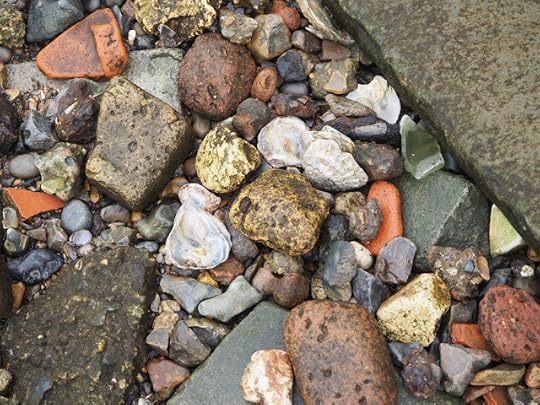
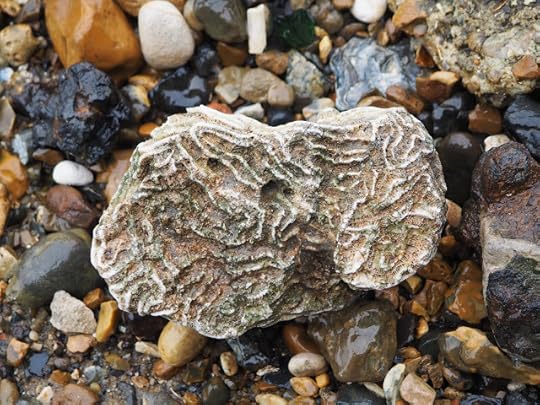
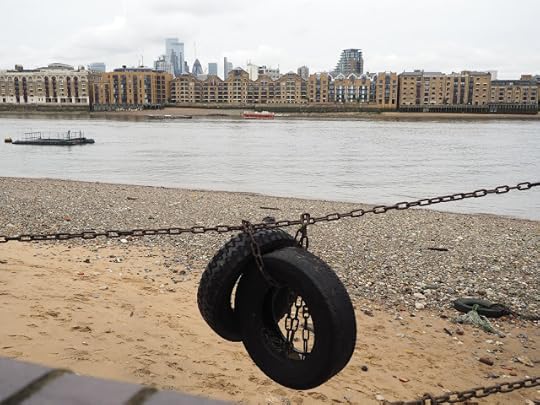
Somebody had built a sandcastle,
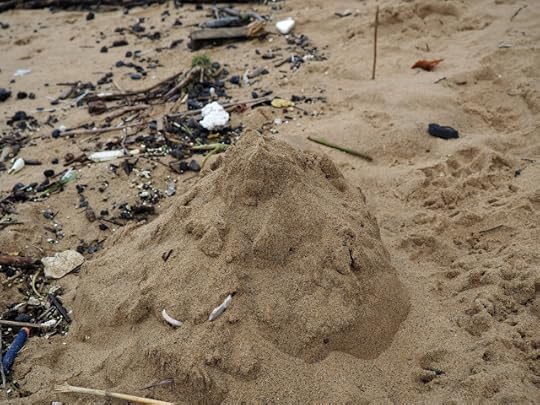
Somebody had left or lost a boot
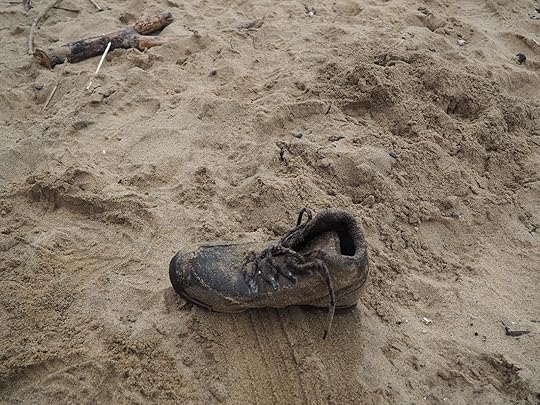
Of course when you’re on the south side of the Thames you stare across the water at the architecture on the north side
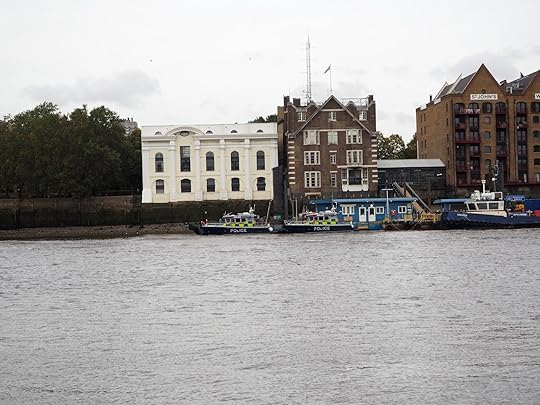
but there were one or two architectural wonders on our side too, such as this nice bit of streamlined modernity:
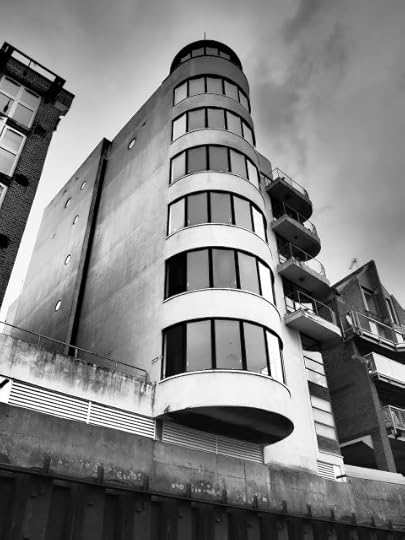
Now as you know, I’m a great picker up of trifles, or souvenirs, or rubbish, on my walks. But the fact is, you’re not allowed to remove things from the foreshore without a permit, and we didn’t have a permit so we took only photographs, left only footsteps, as the saying goes.
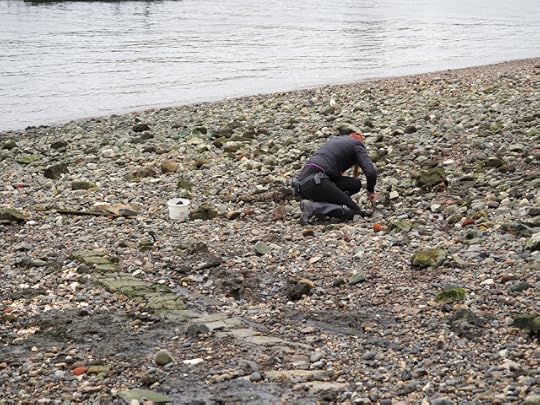
The woman above did have a permit, she said (we didn’t ask to see it) but she also said she hadn’t found anything very interesting.
There was even a sign in one spot, possibly not official, that said, ‘don’t move the stones’ but since the simple act of walking made stones move this was hard to obey. And you know there weren’t any cops patrolling the foreshore, unless they had some secret and inscrutable method of surveillance.
However I did find this:

It was a small glass jar with what appeared to be a wet and tattered five pound note around it, held in place by rubber bands.
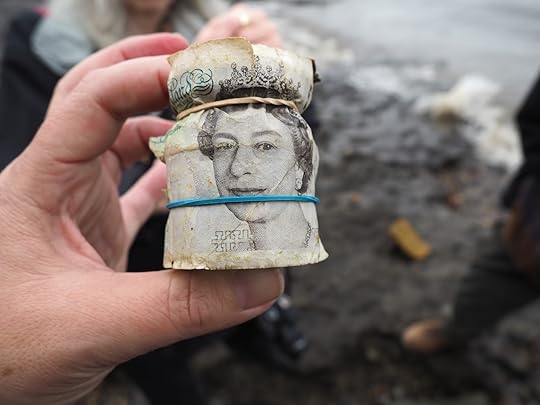
I picked it up and the five pound note looked real enough though probably too tattered to be legal tender. But I removed the fiver and found what appeared to be two genuine and perfectly intact Chinese bank notes under it, also wrapped around the jar.
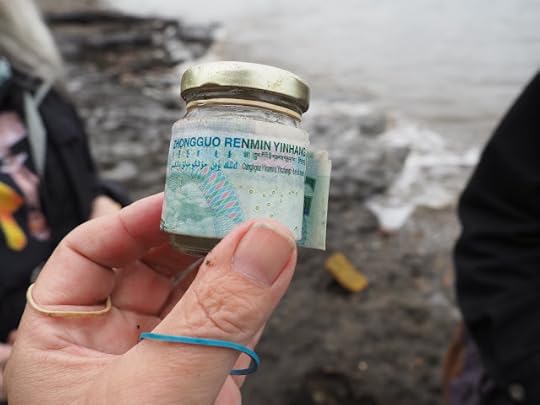

Suspecting contraband or, say, a trafficked human pituitary gland, inside the jar (though I suppose a human pituitary gland is a kind of contraband), I opened it up, and as far as I could tell it contained only river water. What it had contained previously is anybody’s guess. And obeying the law of the foreshore, I wrapped the notes around the jar again, replaced the rubber bands and put it back among the rocks more or less where I'd found it. It was the right thing to do.
Nevertheless it’s the kind of thing I’m going to be thinking about for years. I mean, who wraps English and Chinese bank notes around a glass jar and throws it in the Thames? If we’d been living in a novel this would have been the start of a great and rip-roaring adventure. As it was, we went to the pub.
Then we went back to Bermondsey tube station for some fairly hard core Brutalism. London, she’s exhaustible, innit?

October 22, 2023
MEANDERING IN EDEN
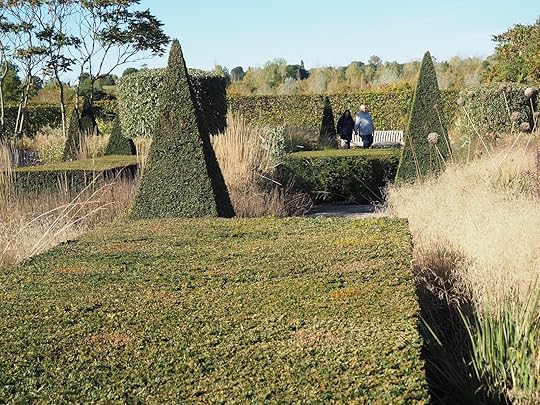
I was thinking about the viability of my ‘walking in gardens’ project, and how to make it interesting, when I had an idea. Since walking in gardens is a low key, low intensity activity, I reckoned that what was needed was some added rigour.
I wondered how it would be if, instead of just wandering around a garden, going wherever your feet and your eyes take you, you went to a somewhat well-known location, say the RHS garden at Hyde Hall, in Essex, set over 360 acres of more or less rolling hills, and made your walking schematic. Now obviously there are different kinds of scheme and rigour that could be applied but I thought I’d begin simply enough, by walking systematically down every single path in the garden. Fortunately there was a map.

I’d been to Hyde Hall before and found one or two favourite spots; the Dry Garden and the Winter Garden especially, but this was no time to back favourites. As far as the walk was concerned one place was as good as any other, the Rose Garden, the Global Growth Vegetable Garden, Sky Meadow, the Queen Mother’s Garden, the Floral Fantasia, the Sky Meadow, and so on, all had to be treated as equals as I walked the paths.
My trusty amanuensis and I started in a section known as the Birch Grove and there was a rather poetic introductory sign that included the words, ‘Meandering paths immerse you in an airy woodland, dappled and cool in the summer sun.’
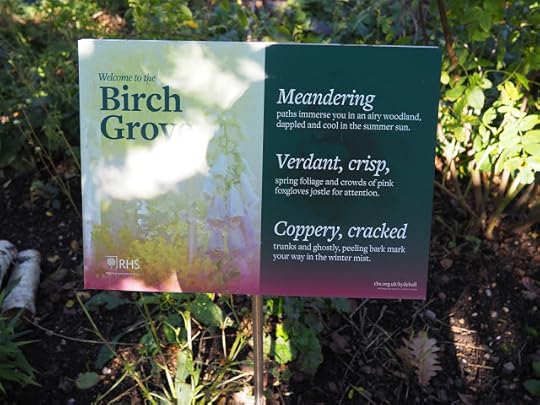
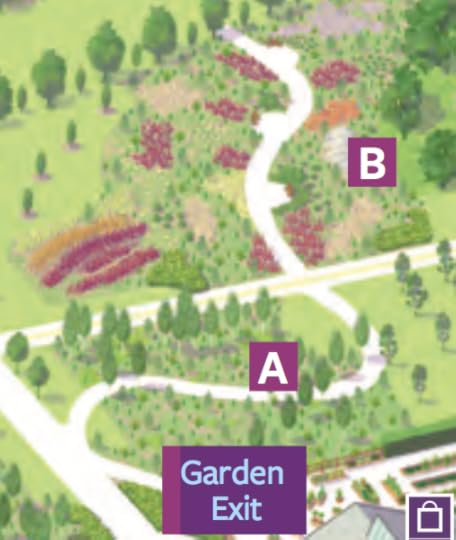
In fact it was autumn, but even so that sign set me thinking: here it's the path that meanders, not the walker. And I wondered if you walked rapidly along a meandering path could you still be said to meander? I admit it isn’t one of life’s greatest questions.
And so we walked. And inevitably we walked in places we might otherwise not have. I’m sure, for example, I’d have avoided the Children’s Play Area and yet there was the Grand Bug and Pest Hotel.
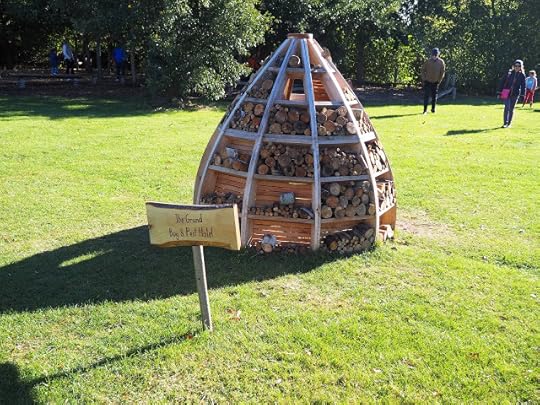

Who’d have thought there were fans of Wes Anderson at the RHS?

We covered the ground and the paths. NB - that isn't us in the picture above. There were no Keep Off The Grass signs and occasionally we did stray off the path. There were also one or two desire lines and you might well ask whether a desire line can be construed as a path, and I’d say it probably can, though I wouldn’t fight about it, and in any case we avoided them: the desire lines not taken.
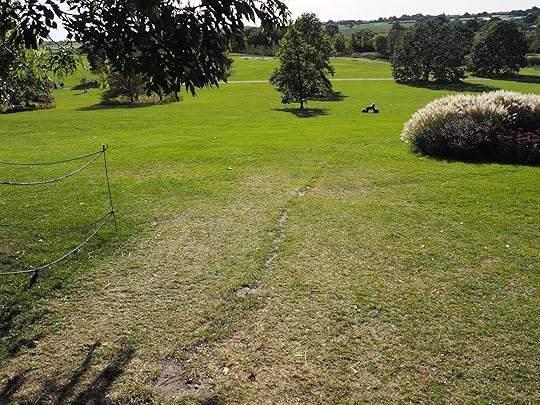
To be honest I think by the end, as our resolve faltered, we may have missed a few short stretches of path but for a first expedition it wasn’t too bad.
There were others walking too. As a cross section of British society it was hardly representative but as a snapshot of the kind of people who like to walk in gardens it was probably typical – mostly older, mostly couples, mostly though not exclusively white, a few parents and children, some of the kids looking bored, others looking dangerously excited. Nobody else seemed to be walking rigorously.

And somewhere in the course of the walk I started to wonder whether this could be considered a form of psychogeography. And you know, after deep reflection, I do believe it could. Debord says psychogeography is ‘the study of the precise laws and specific effects of the geographical environment, consciously organized or not, on the emotions and behavior of individuals.’ And heck, a garden of any size is full of varying geographic elements and full of specific (and sometimes vague or downright ambiguous) effects, as you move from one part to another. At Hyde Hall the ‘feel’ of the Birch Grove was very different from that of the Dry Garden, the Floral Fantasia was very different from the Global Growth Vegetable Garden. So hell yes, walking in gardens may be considered a form of psychogeography. Whether this makes my walking in gardens project any more viable, remains to be seen.
Geoff Nicholson's Blog
- Geoff Nicholson's profile
- 55 followers




